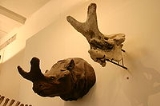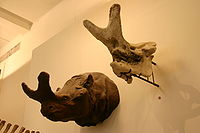
Megacerops
Encyclopedia
Megacerops is an extinct genus
of the family
Brontotheriidae
endemic to North America
during the Late Eocene epoch (38—33.9 mya), existing for approximately .
According to Mihlbachler and others , Megacerops includes the species of the genera Menodus
, Brontotherium
, Brontops
, Menops
, Ateleodon
, and Oreinotherium
s on their snout (the size varying between species), with the horns of males being much larger than those of the females. This could indicate that they were social animals which butted heads for breeding privileges.
A single specimen was examined by M. Mendoza for body mass and was estimated to have a weight of 1000.2 kg (2205 lbs).
 Fossils were uncovered in the northern plains states. A life-sized model of a Megacerops family (a male, female, and juvenile) is displayed at the Canadian Museum of Nature
Fossils were uncovered in the northern plains states. A life-sized model of a Megacerops family (a male, female, and juvenile) is displayed at the Canadian Museum of Nature
.
Genus
In biology, a genus is a low-level taxonomic rank used in the biological classification of living and fossil organisms, which is an example of definition by genus and differentia...
of the family
Family (biology)
In biological classification, family is* a taxonomic rank. Other well-known ranks are life, domain, kingdom, phylum, class, order, genus, and species, with family fitting between order and genus. As for the other well-known ranks, there is the option of an immediately lower rank, indicated by the...
Brontotheriidae
Brontotheriidae
Brontotheriidae, also called Titanotheriidae, is a family of extinct mammals belonging to the order Perissodactyla, the order that includes horses, rhinoceroses, and tapirs. Superficially they looked rather like rhinos, although they were not true rhinos and are probably most closely related to...
endemic to North America
North America
North America is a continent wholly within the Northern Hemisphere and almost wholly within the Western Hemisphere. It is also considered a northern subcontinent of the Americas...
during the Late Eocene epoch (38—33.9 mya), existing for approximately .
Taxonomy
Megacerops was named by Leidy (1870). Its type is Megacerops coloradensis. It was synonymized subjectively with Menodus by Clark and Beerbower (1967). It was assigned to Brontotheriidae by Leidy (1870), Carroll (1988), Mader (1989) and Mader (1998)According to Mihlbachler and others , Megacerops includes the species of the genera Menodus
Menodus
Menodus giganteus is a species of brontothere. The best known specimen is a mounted skeleton in the Field Museum of Natural History.According to one source , M. giganteus is merged into the genus Megacerops....
, Brontotherium
Brontotherium
Brontotherium is an extinct genus of prehistoric odd-toed ungulate mammal of the family Brontotheriidae, an extinct group of rhinoceros-like browsers related to horses. The genus was found in North America during the Late Eocene....
, Brontops
Brontops
Brontops is an extinct genus of rhinoceros-like perissodactyl mammal.According to one source, Brontops is subsumed into genus Megacerops.-Appearance:...
, Menops
Menops
Menops is a genus of brontothere that had very small or no horns.According to one source, the species of Menops are merged into the genus Megacerops.-References:...
, Ateleodon
Ateleodon
Ateleodon is a genus of brontothere from the late Eocene of North America-Taxonomy:According to Mihlbachler and others , Ateleodon is synonymized with Megacerops, which also includes the species of the genera Menodus, Brontotherium, Brontops, Menops, and Oreinotherium...
, and Oreinotherium
Oreinotherium
Oreinotherium is a genus of brontothere.According to one source, the species of Oreinotherium are merged into the genus Megacerops.-References:...
Morphology
All of the species had a pair of blunt hornHorn (anatomy)
A horn is a pointed projection of the skin on the head of various animals, consisting of a covering of horn surrounding a core of living bone. True horns are found mainly among the ruminant artiodactyls, in the families Antilocapridae and Bovidae...
s on their snout (the size varying between species), with the horns of males being much larger than those of the females. This could indicate that they were social animals which butted heads for breeding privileges.
A single specimen was examined by M. Mendoza for body mass and was estimated to have a weight of 1000.2 kg (2205 lbs).
Fossil distribution

Canadian Museum of Nature
The Canadian Museum of Nature is a natural history museum in Ottawa, Ontario, Canada. Its collections, which were started by the Geological Survey of Canada in 1856, include all aspects of the intersection of human society and nature, from gardening to gene-splicing...
.

